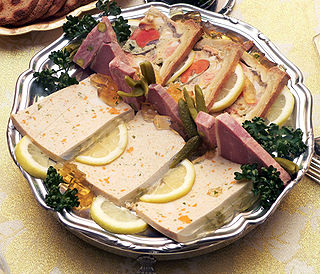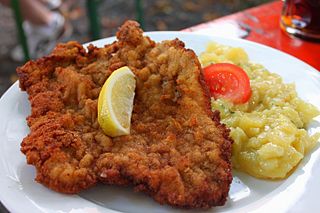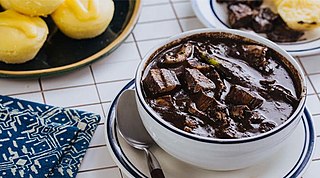See also

Lights are the lungs of game or livestock as used in cooking and butchery. Although technically offal, lights are rarely used in English-speaking culinary traditions, with the exception of the Scottish national dish haggis.
In Malaysia, slices of beef lights (paru, literally "lung" in Malay) are coated in flour and turmeric powder, deep-fried, and sold in packets at street markets. These are a very popular snack eaten with chilli sauce and a dash of vinegar.
Bopis (Spanish : bópiz) is a piquant Philippine dish of pork or beef lungs and heart sautéed in tomatoes, chilies and onions.


Haggis is a savoury pudding containing sheep's pluck, minced with chopped onion, oatmeal, suet, spices, and salt, mixed with stock, and cooked while traditionally encased in the animal's stomach though now an artificial casing is often used instead. According to the 2001 English edition of the Larousse Gastronomique: "Although its description is not immediately appealing, haggis has an excellent nutty texture and delicious savoury flavour".

Veal is the meat of calves, in contrast to the beef from older cattle. Veal can be produced from a calf of either sex and any breed; however, most veal comes from young male calves of dairy breeds which are not used for breeding. Generally, veal is more expensive by weight than beef from older cattle. Veal production is a way to add value to dairy bull calves and to utilize whey solids, a byproduct from the manufacturing of cheese.

Tripe is a type of edible lining from the stomachs of various farm animals. Most tripe is from cattle, pigs and sheep.

Scrapple, also known by the Pennsylvania Dutch name Pannhaas, is a traditional mush of fried pork scraps and trimmings combined with cornmeal and wheat flour, often buckwheat flour, and spices.

Offal, also called variety meats, pluck or organ meats, is the internal organs of a butchered animal. The word does not refer to a particular list of edible organs, and these lists of organs vary with culture and region, but usually exclude skeletal muscle. Offal may also refer to the by-products of milled grains, such as corn or wheat.

White pudding, oatmeal pudding or mealy pudding is a meat dish popular in the British Isles.

Schnitzel is a thin slice of meat. The meat is usually thinned by pounding with a meat tenderizer. Most commonly, the meat is breaded before frying. Breaded schnitzel is popular in many countries and is made using veal, pork, chicken, mutton, beef, or turkey. Schnitzel originated as wiener schnitzel and is very similar to other breaded meat dishes.

Dinuguan is a Filipino savory stew usually of pork offal and/or meat simmered in a rich, spicy dark gravy of pig blood, garlic, chili, and vinegar.
A collop is a slice of meat, according to one definition in the Oxford English Dictionary. In Elizabethan times, "collops" came to refer specifically to slices of bacon. Shrove Monday, also known as Collop Monday, was traditionally the last day to cook and eat meat before Ash Wednesday, which was a non-meat day in the pre-Lenten season also known as Shrovetide. A traditional breakfast dish was collops of bacon topped with a fried egg.

Ragout fin is a time-consuming entrée. Its origin in France is not confirmed, and it appears to have been created by Huguenot immigrants in Berlin. A similar dish is in East Germany known as Würzfleisch, which uses pork or chicken instead of veal.
In the cuisine of modern Rome quinto quarto is the offal of butchered animals. The name makes sense on more than one level: because offal amounts to about a fourth of the weight of the carcass; because the importance of offal in Roman cooking is at least as great as any of the outer quarters, fore and hind; and because in the past slaughterhouse workers were partly paid in kind with a share of the offal.
Sonofabitch stew was a cowboy dish of the American West.

Batchoy, alternatively spelled batsoy, is a Filipino noodle soup of pork offal, crushed pork cracklings, chicken stock, beef loin, and round noodles. The original and most popular variant, the La Paz Batchoy, traces its roots to the Iloilo City district of La Paz, in the Philippines.

Fricassee or fricassée is a stew made with pieces of meat that have been browned in butter then served in a sauce flavored with the cooking stock. Fricassee is usually made with chicken, veal or rabbit, with variations limited only by what ingredients the cook has at hand.
Devizes pie is a dish closely associated with the town of Devizes, Wiltshire, England. It is a pie which consists of offal within a huff paste casing. It was thought to originate from the 15th century, but fell out of fashion several times. It was first rediscovered in the 1950s and 1960s, and again in 2006. Some modern recipes have replaced the majority of the offal with other proteins.

Fuqi feipian is a popular Sichuan dish, served cold or at room temperature, which is made of thinly sliced beef and beef offal. Common ingredients in the modern version include beef heart, tongue and tripe, and a generous amount of various spices, including Sichuan pepper. True to its Sichuan roots, the desired taste should be both spicy and mouth-numbing. Despite its name, actual lung is rarely used.

Tjvjik, tzhvzhik or dzhvzhig is an Armenian dish which is mainly based on liver. In addition to liver it can include any other offal. It is considered an easy dish to prepare.